Sparton Corp.
Sparton Corporation is a contractor for maritime defense systems, including sonobuoys and inertial sensors, founded in 1910. They were formerly a manufacturer of radios, televisions, stereos, and the main focus of this article, various models of outdoor, industrial, and vehicular sirens.
History
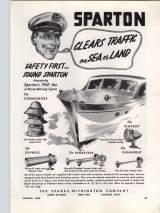
Sparton was founded as the Withington Co. in 1900 in Jackson, Michigan, by Philip and Winthrop Withington. William Sparks became the third partner in the business a few years later and the company name was changed to the Sparks-Withington Company. Sparks-Withington began as a small manufacturer of steel parts for agricultural implements but as the automobile revolution began to sweep through Michigan in the early part of the century, Sparks-Withington added steel automotive stampings like hub caps and brake drums to their product line. Sparks-Withington had a Canadian division which was based out of Walkerville, Ontario. Sometime in the mid-to-late 1930s to early 1940s, Sparton began to produce various outdoor and vehicular warning sirens, with one advertisement for them dating back to 1940.
Sparton's sirens were intended to compete with the industry giants (namely Federal Signal), but never saw widespread use. In the 1950s, Sparton engineers began to develop a sonobuoy system for the US Navy, receiving their first sonobuoy contract in 1951. A couple of years later in 1956, Sparks-Withington's name was officially changed to Sparton, a contraction of the company name and an evocation of the disciplined Spartans of Ancient Greece. By 1956, Sparton had discontinued production of their radios, televisions, stereos, and sirens, which had been the company’s largest product categories, in order to concentrate on automotive parts and the growing sonobuoy market.
Sparton entered into a joint venture with Magnavox (now Ultra) in 1984, named ERAPSCO (Expendable Reliable Acoustic Path Sonobuoy Company) for design, development and manufacturing of U.S. Navy sonobuoys and transducers. In 1996, the company had left the highly competitive and declining automotive supply business to shift their focus on sonobuoys. By 2010, sonobuoy usage was again on a steady rise and the ERAPSCO venture expanded to encompass sales of all sonobuoy variants to the US Navy and entered into 5-year, sole source, Indefinite Delivery Indefinite Quantity (IDIQ) contracts which were evenly split between the joint venture partners. Sparton was purchased by Cerberus in 2018 and acquired by Elbit Systems of America in 2021.
Sirens
Vehicular/Industrial sirens
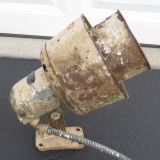
Model 35
The Model 35 is a small directional siren, advertised as intended for use in small communities, railroad yards, docks, warehouses, car barns, business buildings, apartments, industrial plants, or local fire stations. The Model 35 was intended to compete with the Federal Electric Model A and Sterling Type F and is internally very similar to them. The siren uses a small 8-port rotor and stator driven by a ½ hp universal motor. The Model 35 operates on 110 V AC, and the rotor and stator are shielded by a small horn. The siren uses a long, slightly conical intake which includes a steel mesh screen to keep debris out of the siren. The motor and stator are a single cast, meaning that the motor is not removable from the siren. The siren is mounted on a swivel base, which allows the siren to be tilted vertically to face any intended direction. The Model 35 is very rare, with few examples in existence today. One operating example survives in private possession by Midwest Siren Productions.
Model 36
The Model 36 is a small siren designed for emergency response vehicles, like fire trucks, ambulances, & police cars. It is advertised to be able to run on any electrical current that is 110 volts or lower. They were finished with chromium plating, and they were often painted chrome. These sirens would sell for about $42.50 when they first released. Sadly, no known models are known to exist today, making it hard to learn about these sirens.
Model 200
The Model 200 is a small, omnidirectional boat siren that is available in either 6, 12, or 32 volt motors. this siren was also nicknamed "The Commodore." The model 200 also had 2 models, the Model 200 and the Model 201. The Model 200 had a price of $21.95, and had a chrome color to it. The Model 201 was more affordable at a price of $18.45, and it was practically the same siren, except it was made out of brass. None are known to exist today.
Model 203
wip
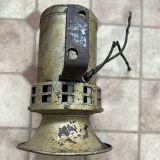
Model 214
The Model 214 is a small directional siren, and seems to be a rebrand of the E.A. Laboratories SirEAne Jr., with the only difference between the two being the tags. It is a small vehicular directional siren, consisting of a small 8-port rotor and 12-port stator with finger guards on each port to prevent injury from misuse of the siren, as it is small enough to be handheld. The siren is driven by a small 6 or 12 V motor located behind the stator and is housed inside a large cylindrical enclosure. A large, flared horn is bolted to the front of the stator to increase sound output. Some units are also known to have a screen inside of the horn to prevent debris from entering the rotor. The entire assembly sits upon a small mount beneath the motor housing. The siren measures around 7½" long, 5" wide, and 5½" tall. It is unknown if the SirEAne Sr. was also rebranded by Sparton, as no Sparton branded units are known to exist.
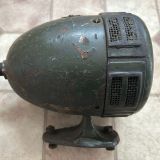
Model 601
The Type 160-A, a product of Federal Electric, was also offered under the Sparton brand, under the name Model 601. The siren makes use of a 6-port rotor and stator, with finger guards on each port to prevent injury from misuse of the siren, as it is small enough to be handheld. The siren is advertised as having the same stator design as the Type 160-A; however, on all existing units, the stator's cast has minor differences compared to its original counterpart. Some units also have differences in the design of their stators. The siren is driven by a small 6, 12, or 24 V motor located behind the stator and is housed inside a large bullet-shaped enclosure, which rests upon a pedestal with 2 holes located on each side of its oval shaped base, allowing for the siren to be mounted to a flat surface. A grille, the cast of which differs from the original siren, is bolted to the front of the stator to prevent debris from entering the rotor; a screen is also located behind it. The grille on the siren differs from existing units and the depiction in a 1942 ad, with the depiction of the siren in the ad having a more bulbous grille and a design casted on its center compared to existing units which have no design and a grille that is flattened out. The siren measures around 5½" tall and 4½" wide.
Outdoor warning sirens

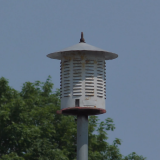
Model 37
The Model 37 is a small omnidirectional siren intended to compete with the Federal Electric Fedelcode Model 1, Model 2, and Sterling Model 2V8, and was the most popular outdoor warning siren sold by Sparton. The Model 37 makes use of a 14" 5-port rotor, which is driven by a 1 hp AC/DC universal motor, running at roughly 7600 rpm. The siren intakes from both the top and bottom of the rotor, with 6 holes on the bottom of the housing allowing air into the siren. A mesh screen protects these intakes from debris.
The stator has two large rings that help project the sound outwards, and there is a tall metal rod which has an eyebolt on top bolted to the stator, held up by 4 legs. The siren's base has 3 lugs, intended to be used for roof mounting. This rod holds up the siren's cylindrical housing, which has a large number of small vents which allow the sound to escape the housing, a similar design choice to the earlier Decot Red Arrow as well as the W.S. Darley Weatherproof Champion. The housing itself sits on four mounting legs. A rain shield is included on top of the housing to keep moisture and debris out of the siren.
The design of the Model 37's housing is severely flawed, however, as much of the siren's sound output is blocked due to the housing being too obstructive. As a result, the Model 37 is relatively quiet for its size, being greatly outperformed by a Model 2. These are the most commonly found model surviving today, with one in private possession by Calvin Mayer, one in active service as a noon blaster, and several sitting inactive. They are commonly mistaken with the taller Model 38.
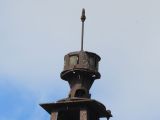
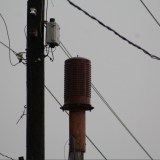
Model 38
The Model 38 is a larger, more powerful version of the Model 37, using roughly the same design. The siren filled a similar role to the Model 37, being a small omnidirectional siren intended to compete in the same market as the Model 37. The Model 38 makes use of a 14" 5-port rotor and stator, which are driven by a 2 hp AC/DC universal motor, running at roughly 6800 rpm. This makes them slightly lower pitched than a Model 37. The rotor and stator are taller than the Model 37's, although they share the same diameter. The stator lacks the rings that the Model 37's has, and like the Model 37, the siren intakes from both the top and bottom of the rotor.
The siren's metal housing is held up by a tall metal rod bolted to the stator, held up by 4 legs, with an eyebolt above it. The housing is similar to a Model 37's but is 5" taller to fit the taller siren inside. The housing is cylindrical in shape, with many small vents allowing the sound to escape. A rounded rain shield is on top of the siren, which differs from the Model 37's conical one. Like the Model 37, the Model 38's housing is severely flawed, greatly hampering performance by being too obstructive. These sirens are very commonly mistaken by enthusiasts for Model 37s but can be differentiated by the taller housing. Few of these sirens survive, with a few units sitting inactive and another in private possession by Adam Pollak. No active examples are known to exist.
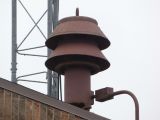
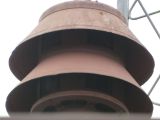
Model 39
The Model 39 is the largest siren that was offered by Sparks-Withington and uses a unique design. The Model 39 is a dual rotor, vertical omnidirectional siren with a very similar design to a H.O.R. Siro-Drone. The Model 39 makes use of two 14" 5-port rotors and stators, both driven on the same single rotor shaft by a single phase 3 hp AC motor running at 5700 rpm. The siren uses the same rotor and stator from the Model 38, with two of them stacked vertically like some H.O.R. Sirex units, however the siren is 5/5-port single tone. The top rotor intakes from the top, while the bottom rotor intakes from below, and each stator has a steep louvre attached which directs the sound down and outwards, very similar to a Fedelcode era Model 5 C3 1/2. A rounded rain shield is located on top, with an eyebolt attached. The siren's motor is bare, with no protection from the elements.
This model did not sell as well as the other models, with only two units surviving today. One intact, inactive example is located in Jackson, MI, where the company was based out of. Another example was sat on top of the abandoned Sparton headquarters building in north Jackson before being almost completely destroyed when the building caught fire in mid-2023. The rotors melted and the stators fell off, leaving only the mount, motor, skirt, & hood intact.